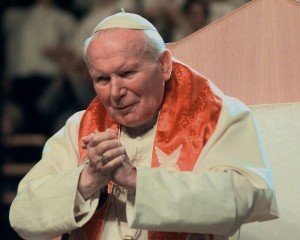
The Vatican announced Friday that Pope John Paul II will be beatified on May 1, meaning it has been decided that he has performed at least one miracle. If he is found to have performed a second miracle, he will be canonized as a saint. The miracle in question concerns a French nun, who was diagnosed with an aggressive form of Parkinson’s disease but was reportedly cured in 2005, one morning after writing the pope’s name on a piece of paper. (John Paul II had died of the same disease just two months earlier.) But how does the Catholic Church decide what constitutes a miracle?
It’s a multistep process including an investigation by a specially designated Vatican office culminating in a final decision by the pope himself. Global celebrities like John Paul II or Mother Teresa — beatified in 2003 — aren’t particularly representative examples of the process. Most beatifications (the church carries out around 30 every year) are granted to people who were little known outside their communities.
In an ideal version of the process, a grassroots movement grows in a community as people come to the conclusion that the person lived a saintly life. The local bishop then “opens a cause” and performs his own investigation. If he’s satisfied, the cause is then referred to Rome. The investigation is then taken up by the Congregation for the Causes of the Saints, a Vatican office tasked with “approving results on miracles, martyrdom and heroic virtues of various Servants of God.” As with much of the Vatican hierarchy, the criteria for membership in the Congregation is a bit opaque, but the head prefect — currently Cardinal Angelo Amato — is directly appointed by the pope.
Theoretically, miracles can be of any type. But in recent years, the vast majority of cases have been miraculous healings of deadly medical conditions. The church is still extremely traditional in the types of deeds it considers miraculous and has shown little inclination toward including political accomplishments, so don’t expect to see John Paul II canonized for his role in the downfall of Soviet communism.
When the Congregation begins its investigation, it first seeks the advice of a panel of doctors that it maintains throughout the world. For a recovery to be declared miraculous, it must be “complete,” “instantaneous,” and “durable” — meaning the cured condition doesn’t return — as well as scientifically inexplicable. (Improvements in medicine and scientific understanding of the body don’t seem to have slowed down the pace of beatifications much.)
After the doctors have signed off, it goes to a panel of theologians who then have to judge whether the miracle is the sort of thing that God would do. After that, it goes before the cardinals and bishops of the Congregation for the Causes of the Saints, who are entrusted with ensuring that the beatification is in the church’s best interest — a particular beatification may or may not be politically opportune any given time. Finally, it is referred to the pope himself, who has the final say.
The second miracle, needed for sainthood, can come a few months or a few centuries after the first. This is partly because it can take a while for new miracles to occur, but also because political realities change. Holy figures can become increasingly popular or influential, or less so, over the years, leading the congregation to reopen their causes. Causes are never permanently closed. The Congregation keeps a file of all those considered for beatification on record in the Vatican archives, but the vast majority of those who are beatified will never become saints. The last new saints were a group of six — including the first ever Australian — canonized by Benedict XVI on Oct. 17. There are currently over 10,000 named saints.
Normally, individuals are only considered for beatification after they’ve been dead for five years, but in John Paul’s case, the process was fast-tracked. There are a few likely reasons for this. The late pope is a globally known and loved figure, so there’s no reason to wait for support to build. Because of his popularity among Catholics, his eventual sainthood is generally considered a foregone conclusion. The 83-year-old Benedict, who worked at John Paul’s side for years, is believed to want to see through his mentor’s canonization himself. Plus for the Catholic Church, in the midst of a number of political, financial, and sexual scandals, some good publicity couldn’t hurt.
BY JOSHUA E. KEATING

Leave a Reply
You must be logged in to post a comment.